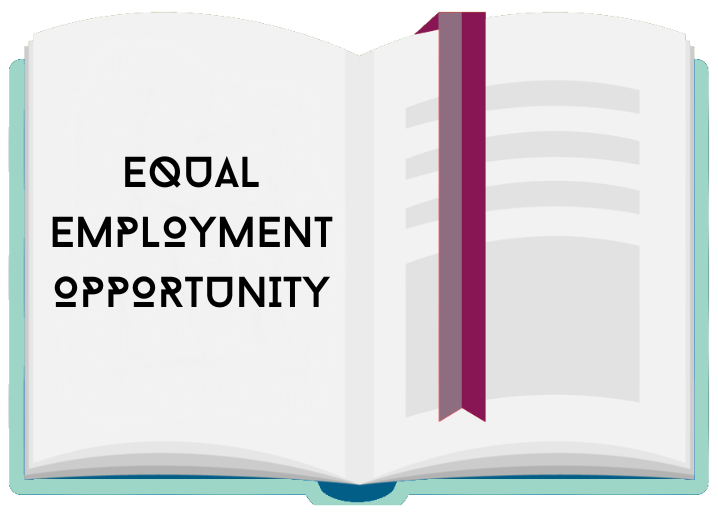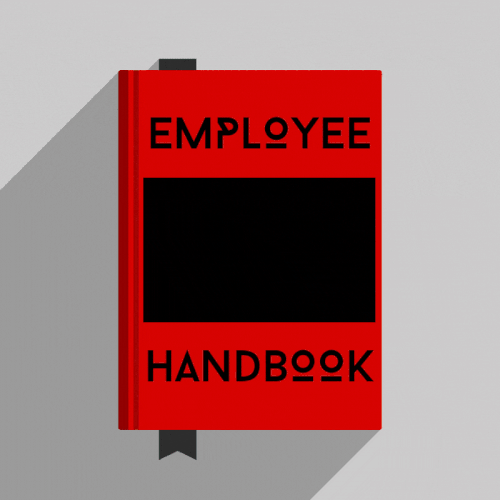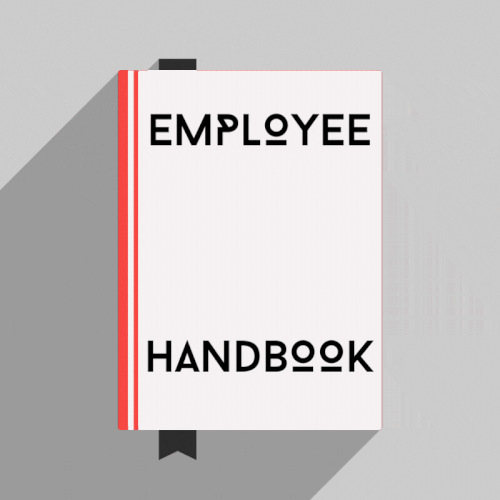As any business owner knows, a well-run company depends on clear communication and a shared understanding of the rules and expectations. An employee handbook can be an essential tool in establishing these standards.
A good employee handbook should clearly outline the company’s policies on attendance, Dress code, work hours, and other important topics. It should also provide employees with a clear understanding of the consequences of violating these policies.
By taking the time to create a comprehensive and well-written employee handbook, businesses can create a foundation for a productive and cohesive workplace.
“The survey covered seven major handbook-related challenges and found that 66% of participating HR representatives rated ‘getting employees to read their organization’s handbook’ as either ‘somewhat’ or ‘very’ challenging.” — XpertHR
Whether you’re just starting out or you’ve been in business for years, an employee handbook can be a valuable asset. Investing the time to create one can pay off in a more efficient and harmonious workplace.
P.S. While you’re at it, get the free secret weapon HR professionals are keeping in their toolkits.
What Is An Employee Handbook?
An employee handbook is a document that outlines a company’s policies and procedures. It covers topics such as dress code, attendance, vacation time, and harassment. The employee handbook is a way for the employer to communicate its expectations to employees. It can also help to protect the company from legal liabilities.
For example, if an employee is disciplined for not following a policy that is outlined in the handbook, the company can show that it made a good-faith effort to inform the employee of the rule. In short, an employee handbook is a valuable tool for both employers and employees.
Why Is It Important To Create An Employee Handbook?
1) Helps Deal With Conflict Resolution
By outlining expectations and providing clear guidelines for handling disagreements, an employee handbook can help to prevent and resolve conflict. As such, an employee handbook can be a valuable tool for promoting a healthy workplace.
2) Protects Your Company From Liability
An employee handbook is a tool that can be used by businesses to protect themselves from liability. The handbook can outline the expectations and rules of conduct for employees, and provide guidance on how to handle potential problems.
Having a well-written and up-to-date employee handbook can help to shield a company from legal action, by demonstrating that the company took reasonable steps to prevent and address issues. To ensure your company is 100% safe, check out implementing Bambee, the HR compliance solution.
3) Gives HR A Foundation To Build Around
A well-crafted employee handbook can be an essential tool for Human Resources professionals. Not only does it provide a clear overview of company policies and procedures, but it also sets forth expectations for employee behavior. In addition, the handbook can help to reduce the risk of legal disputes by clearly defining the rights and responsibilities of both employees and employers.
By establishing a foundation of clear and concise policies, the employee handbook gives HR a solid platform to build upon.
4) Gives Employees A Place To Learn More About The Company They Are Joining / Working For
A company’s employee handbook is much more than a list of dos and don’ts. It is a document that helps new employees learn about the company’s culture, values, and history. In many cases, the handbook will also provide an overview of the company’s benefits and policies. By taking the time to read through the handbook, employees can get a better sense of what it means to be part of the organization.
Tip! You can make managing the entire onboarding process easier by using a centralized hub like monday.com.
For distributed teams, an online collaboration tool can help both managers and new hires access important documents, files, and schedules in an easy-to-use platform.

Courtesy of monday.com
This tool can help free your team from repetitive manual tasks and endless email threads, so they can focus on goals and create real impact.
5) Provides A Valuable Part Of The Overall Company Culture And Mission
The handbook can help to promote a positive company culture by highlighting the company’s values and mission statement.
6) Answers Questions That Employees Have
An employee handbook is a valuable resource for any questions employees may have about their job, from the company’s policies to their benefits. It can also answer questions about how to handle specific situations that may come up at work.
What To Include In an Employee Handbook
1) Workplace Protections
Workplace protections are laws and regulations that aim to ensure a safe and fair work environment. They cover a wide range of topics, including discrimination, harassment, and wages.
Workplace protections vary from country to country, but some of the most common include the right to form a union, the right to paid leave, and the right to a minimum wage. In addition to protecting workers, workplace protections can also help to improve productivity and morale. By creating a level playing field, they encourage employees to focus on their work, rather than on worrying about unfair treatment.
2) Equal Employment Opportunity (Antidiscrimination)
The Civil Rights Act of 1964 outlaws discrimination in employment on the basis of race, color, religion, sex, or national origin.
This legislation leveled the playing field for all job seekers and helped to ensure that everyone would have an equal opportunity to find employment. The Equal Employment Opportunity Commission (EEOC) is responsible for enforcing the law and investigating claims of discrimination.
Anti Harassment
There are a variety of ways to address workplace harassment, but one of the most important is to create a clear anti-harassment policy. This policy should outline what constitutes harassment and what the consequences will be for violators.
Anti Retaliation
Workplace retaliation is when an employer subjects an employee to adverse action because the employee reported misconduct or participated in an investigation of misconduct. Some examples of adverse actions are demotion, termination, negative performance reviews, and reduced hours or pay.
3) At-Will Nature Of Employment
In the United States, employment is generally considered to be “at will.”
For example, if an employee is not working out, the employer can let them go without having to go through a lengthy and expensive termination process. Similarly, an employee who is unhappy with their job can quit at any time without having to give notice.
4) Code Of Conduct
A code of conduct is a set of rules that outline the expectations for behavior within a community. codes of conduct are often used in workplaces, schools, and other settings where people interact with one another on a regular basis.
While codes of conduct can vary from one place to another, they typically address topics such as harassment, discrimination, and aggression. By setting clear expectations for behavior, codes of conduct help to create a more positive and productive community.
Absenteeism & Tardiness
Being late or absent can have a serious impact on both individual workers and businesses as a whole. For businesses, absenteeism and tardiness can lead to lost productivity, lower morale, and increased costs. Absenteeism also puts additional strain on coworkers, who may have to pick up the slack.
Alcohol & Drug Policy
A lenient policy may create an environment where employees feel comfortable coming to work even if they have consumed alcohol or drugs. However, this could also lead to more accidents and mistakes on the job. A zero-tolerance policy, on the other hand, may discourage employees from drinking or using drugs before work. But it could also lead to employees feeling resentful or stressed out if they are not allowed to drink or use drugs at all during their leisure time. The best approach for each workplace depends on the company culture and the goals of the business.
Company Property, Misuse, & Damage
The use of company property is a privilege that can be revoked at any time. Misuse or damage of company property will not be tolerated and will result in disciplinary action. Employees are expected to take good care of company property and to report any misuse or damage immediately.
Dress Code
In many workplaces, employees are expected to maintain a certain level of dress. While the specific requirements may vary from one company to another, there are some general guidelines that typically apply. For example, most businesses expect their employees to wear clothing that is clean and presentable. In addition, employees are often expected to avoid clothing that is excessively casual or revealing.
5) Pay Policies
When developing pay policies for employees, it is important to consider a number of factors. First, you will need to decide what type of salary system you will use. This can be based on skills, experience, or job performance.
You will also need to decide how often employees will be paid. Will it be weekly, bi-weekly, or monthly? Once you have established a system, you will need to make sure that all employees are aware of the policy and that they understand how it works — ex: paydays, timekeeping, overtime eligibility, meal and rest periods, etc.
6) Benefits
Employee benefits are a key part of any compensation package. By offering benefits, employers can attract and retain the best talent.
The most common type of employee benefit is health insurance. Health insurance helps employees pay for medical expenses, including doctor visits, prescription drugs, and hospital stays. Other popular benefits include retirement plans, such as 401(k)s and pension plans; life insurance; and disability insurance.
Sick Leave Policy
Most businesses have some sort of sick leave policy in place. This policy usually provides employees with a certain number of days off per year that they can use if they are ill.
Paid Vacation Policy
Paid vacation time can offer a number of advantages for both employers and employees. For employees, paid vacation time provides an opportunity to relax and recharge and enjoy time off, which can lead to increased productivity when they return to work.
Insurance + Retirement Benefits
Employees should be able to find out whether the company offers health insurance, and if so, what the coverage includes. The handbook should also explain the company’s retirement plan, including how much money employees will need to contribute in order to receive benefits.
Paid & Unpaid Leave
Paid leave policies are essential for ensuring that workers are able to take the time they need without facing undue financial hardship. In addition, paid leave can help to improve worker productivity and morale, as employees are more likely to return to work feeling rested and ready to tackle their tasks. Ultimately, paid leave is good for both workers and employers, and it is an essential part of creating a fair and productive workplace.
Including Family & Medical Leave
If a business has 50 or more employees, it often needs to have an FMLA policy.
-
- The Family and Medical Leave Act (FMLA) is a US federal law that provides employees with up to 12 weeks of unpaid, job-protected leave per year for certain qualifying medical and family reasons. The FMLA applies to all public and private employers with more than 50 employees, as well as to all government employers, regardless of size. Employees are eligible for FMLA leave if they have worked for their employer for at least 12 months, and if they have worked at least 1,250 hours in the 12 months preceding the start of their leave. Qualifying reasons for leave include pregnancy, childbirth, adoption or foster care, serious health conditions, or caring for a family member with a serious health condition. The FMLA also provides protections for employees who take leave to care for a covered servicemember with a serious injury or illness.
Process For Filing A Complaint
The process for filing a complaint at work will vary depending on the company’s policies. However, there are a few steps that are generally followed. First, the employee should attempt to resolve the issue with their supervisor, manager, or chief of staff. If this is not possible or the problem is not resolved, the next step is to file a formal complaint with Human Resources. This complaint will be investigated, and if necessary, corrective action will be taken.
Other Things To Include In An Employee Handbook
1) Welcome Letter From CEO Or Founder
A personal welcome letter from the CEO or founder of your company can help to set the tone for your brand. This is an opportunity to share your company’s story and values, and to give customers a glimpse of the people behind the scenes.
Tip! You can also place this welcome letter in a curated employee welcome kit! Adding in a few office supplies, a physical copy of your employee handbook and a branded company t-shirt to your welcome kit can be a great way to introduce your employee to the team.
You might want to consider opting into a new hire welcome program where employees receive their welcome kit automatically either at their desk on their first day or shipped to their doorstep on their first day on the job.

Employee Welcome Kit via Caroo
2) Office Schedule
It’s good for employees to know when the office is closed or if the company is observing holidays.
Most offices have a set schedule that employees are expected to follow. This typically includes set times for arrival, breaks, and departure. Having a set schedule can help to increase productivity by ensuring that everyone is on the same page and knows when they are supposed to be working.
3) Review Process & How To Get A Promotion Or Pay Raise
The process for getting a promotion or pay raise at a job may vary depending on your company’s policies. Just be transparent about what it takes so employees have a target to aim for.
4) Progressive Discipline Or Policy When Behavior Doesn’t Meet Expectations
Most businesses have a progressive discipline policy in place. This policy is designed to deal with employee misconduct in a fair and consistent manner. Under this policy, an employee who commits an infraction will receive a warning or other form of punishment that is progressively more severe with each subsequent offense.
The goal of progressive discipline is to give employees a chance to improve their behavior and avoid termination.
5) A Form To Sign Saying They’ve Read The Staff Handbook & Agree To The Terms
By signing a form acknowledging that they have read and agree to the terms of the staff handbook, employees are agreeing to uphold these standards. This helps to create a professional and cohesive work environment.
Tips For Writing And Maintaining An Employee Handbook
1) Treat your employee handbook as a living thing. It should evolve as the company does and not act as a static document written in stone.
2) After you’ve written a draft, share it with an employment lawyer to make sure everything is legally sound.
3) Don’t be afraid to update things as you develop your company’s mission and goals.
4) Find ways to make it available to employees.
a) Send it to them during onboarding.
b) House it in the company wiki or database.
c) Offer a digital version via your company’s HR software. There are tools like monday.com that make it possible to easily upload your handbook to a shared workspace.
5) Determine what kind of files you would like to distribute your handbook as.
a) Would you like the employee handbook to be saved as a PDF File? Google Doc that is shared with employees?
Employee Handbook Examples & Templates
1) Facebook
Facebook allows users to connect with friends and family, share news and experiences, and join groups and events.
The site also includes features such as Groups, Pages, and Marketplace, which provide additional ways for people to connect and interact. In addition, Facebook also offers a range of services for businesses, including advertising, marketing, and customer support. Overall, Facebook is a powerful tool for staying connected with friends and family, as well as for promoting and growing businesses.
Company mission statement: Facebook’s mission is to give people the power to build community and bring the world closer together. Their goal is to connect billions of people around the world, give them a voice, and help them build relationships with each other. They do this by building technology that makes the world more open and connected. They believe that every person in the world deserves to be connected and that connecting us all will create a more understanding and tolerant world. They also believe that technology can be a force for good, and are building tools to make it easier for people to connect and make positive changes in the world.
What is this employee handbook sample?
The handbook is filled with important information that all employees need to know, from the company’s mission statement to its code of conduct. Perhaps one of the most important sections is the section on diversity and inclusion. In this section, employees are reminded of the importance of creating a safe and welcoming environment for everyone. The employee manual also contains a comprehensive list of resources that employees can turn to if they experience any form of discrimination or harassment.
Why we love this employee handbook template: We love the emphasis on diversity.
2) Netflix
Netflix has been a pioneer in the entertainment industry, and it continues to innovate in order to provide the best possible experience for its customers. In 2013, Netflix became the first streaming service to produce original content with the debut of House of Cards.
Since then, Netflix has released dozens of original series, films, and documentaries. The company has also invested heavily in technological advances such as 4K streaming and artificial intelligence. As a result of its dedication to innovation, Netflix has become the leading streaming platform in the world.
Company mission statement: Netflix’s mission is to entertain the world. They believe that great stories make for great connections and that by connecting people they can foster empathy and understanding. Their aim is to bring people together through the stories we tell – whether those stories are funny, heartwarming, or suspenseful. They strive to create the best possible experience for their viewers so that they can sit back, relax, and escape into another world. They believe that by doing so, they can help make the world a little bit better.
What is this employee handbook sample?
At Netflix, we want our employees to feel like they belong here. We value creativity, collaboration, and respect for others. That’s why we have created a set of guidelines that we call our “Netflix Culture Deck.” This document outlines the specific behaviors that help us build and maintain our strong culture. It is not a traditional “employee handbook” in the sense that it doesn’t list all of our rules and regulations. Instead, it is meant to serve as a living document that captures the essence of who we are and what we stand for. We hope that by sharing this deck with you, you will have a better understanding of what it means to be a part of the Netflix team.
Why we love this employee handbook template: We love Netflix’s emphasis on culture. This employee handbook has served as the template upon which they’ve built a world-famous corporate culture.
3) Valve
Valve is a video game development and digital distribution company based in Bellevue, Washington. The company was founded in 1996 by former Microsoft employees Gabe Newell and Mike Harrington.
Valve’s debut product was the Half-Life game series, which has sold over 50 million copies to date. In 2003, Valve launched its Steam platform, which allows gamers to buy and download games directly to their computers. In addition to its own game titles, Valve also distributes games from other developers through Steam. Today, Valve employs over 400 people and is one of the most successful video game companies in the world.
Company mission statement: At Valve, they believe that gaming is the ultimate form of entertainment. They want to create an environment that is not only fun and immersive but also one that encourages creativity and collaboration. Valve’s mission is to make great games that bring people together. They want to inspire the next generation of gamers and enable them to achieve their potential. They believe in a future where gaming is a positive force in the world, and are committed to making that future a reality.
What is this employee handbook sample?
Hierarchy is great for maintaining predictability and repeatability. It simplifies planning and makes it easier to control a large group of people from the top down, which is why military organizations rely on it so heavily. But when you’re an entertainment company that’s spent the last decade going out of its way to recruit the most intelligent, innovative, talented people on Earth, telling them to sit at a desk and do what they’re told obliterates 99 percent of their value. We want innovators, and that means maintaining an environment where they’ll flourish.
Why we love this employee handbook template: We love that Valve’s employee handbook encourages individuality, creativity, and innovation.
People Also Ask These Questions About Employee Handbooks
Q: How do I write an employee handbook?
- An employee handbook is a document that outlines the company’s policies and procedures. It can be used to orient new employees, provide information on company benefits, and answer frequently asked questions.
Q: Are employers required to provide employee handbooks?
- Employers are not required to provide employee handbooks, but there are several advantages to doing so. A well-written employee handbook can help new employees to understand the company’s policies and procedures. It can also clarify the expectations for job performance and conduct.
Q: What is the purpose of an employee handbook?
- The purpose of an employee handbook is to provide employees with a clear understanding of the company’s policies and procedures. The handbook should be easy to read and understand, and it should cover all of the most important topics relating to employment with the company.
Q: How to write an employee handbook for a small business?
- Writing an employee handbook may seem like a daunting task, but it doesn’t have to be. Although there are many different elements that you can include, the most important thing is to make sure that the handbook is clear and concise. Start by outlining the company’s policies and procedures, then go into more detail about each one. For example, if you have a dress code policy, include a section that explains what is considered appropriate attire. Be sure to also include information about benefits, vacation days, and other perks. By taking the time to write a thorough employee handbook, you can ensure that your employees are well-informed and that your business runs smoothly.
Q: Is an employee handbook a legal document?
- While an employee handbook is not a legal document, it can be an important tool for communicating workplace policies and procedures. An employee handbook can help to protect an organization from claims of discrimination or other legal challenges. By clearly outlining workplace rules and procedures, an employee handbook can help to create a fair and consistent work environment. As a result, while an employee handbook is not legally binding, it can be a valuable tool for promoting a positive and productive work environment.






























